German cuisine gets no respect. People will rhapsodize on and on about the wonders of the “Mediterranean Diet” or “Classical French Cooking” but when it comes to anything west of the Rhine enthusiasm suddenly wanes. Why is this? It certainly does not have anything to do with depth of culture, quality of ingredients or dedication to cuisine. It is interesting to note that more 3-star chefs come from the Alsace region of France than any other. This is interesting because the Alsace region of France is the most heavily German-influenced region in the entire country. In fact, it was part of Germany until World War 1. Coincidence?
German cuisine is delicious and diverse but, sadly, even many German cookbooks are written from an apologists view that German cuisine needs to be “fixed up” or made “more sophisticated”. Why the lack of respect? One problem is that when you say “Germany” you are talking about a country that was only unified in 1871 and has spent a great deal of the time since then divided. This is not a lot of time to develop a national cuisine, especially in a country where many of the states are as notable for their dissimilarities as they are their similarities. This makes “German” cuisine very difficult to quantify.
Regional Cuisine:
Although individually distinct, for the sake of simplicity you can put the sixteen German states into four broad geographical groupings.
 South West Germany (North Rhine-Westphalia, Rhineland-Palatinate, Saarland and Baden-Württemberg): This region can easily be considered to be one of the truly great food centers of the world. More Michelin stars have been earned by Baden chefs then by any other region of Germany. In addition, every person will recognize the famous regional delicacies of Black Forest Cake (Schwarzwalder Torte) and Black Forest Ham (Schwarzwalder Schinken). Traditional specialties are based on this regions status as a fertile garden for many vegetables and a source of high quality wines. As one moves farther north these vegetables are used as a base of hearty soups. Farther south the cuisine shares more influences with the winegrowing traditions of France and Switzerland and shows more subtly and variation. Regional specialties include Spatzle, famous thick German noodles cooked in broth, Snail Chowder with Herbs (Badener Schneckensuepple), Veal and Spinach-Filled Pockets (Maultaschen) and Wine Stewed Beef Roast (Rheinischer Sauerbraten).
South West Germany (North Rhine-Westphalia, Rhineland-Palatinate, Saarland and Baden-Württemberg): This region can easily be considered to be one of the truly great food centers of the world. More Michelin stars have been earned by Baden chefs then by any other region of Germany. In addition, every person will recognize the famous regional delicacies of Black Forest Cake (Schwarzwalder Torte) and Black Forest Ham (Schwarzwalder Schinken). Traditional specialties are based on this regions status as a fertile garden for many vegetables and a source of high quality wines. As one moves farther north these vegetables are used as a base of hearty soups. Farther south the cuisine shares more influences with the winegrowing traditions of France and Switzerland and shows more subtly and variation. Regional specialties include Spatzle, famous thick German noodles cooked in broth, Snail Chowder with Herbs (Badener Schneckensuepple), Veal and Spinach-Filled Pockets (Maultaschen) and Wine Stewed Beef Roast (Rheinischer Sauerbraten).
 Southeast Germany (Bavaria and Hessen): When people think of “German food” the images that come to mind are most often from Bavaria and it’s capital city of Munich. It is here that the great German love of sausages (wurst) and beer take on an almost fevered religious tone. This great love of sausages is also reflected in the neighboring region of Hessen (capital- Frankfurt) provenby he fact that the production of their beloved Frankfurters has been legally controlled since 1929. The signature meal of the region is the standard Bavarian lunchtime meal of White Sausage (Weisswurst) with sweet mustard served with a freshly baked roll and a pint of local wheat beer (weissbier). Bavarian cuisine is also known for other German favorites such as dumplings, pork and cabbage. Regional specialties include Pork roasted in Beer (Bierbratl), Eggs in Green Sauce (Eier in Gruner Sosse), Spit Roasted Baby Pig (Spannferkel), and Spaetzle with Cheese and Butter (Schwaebische Kasespaetzle).
Southeast Germany (Bavaria and Hessen): When people think of “German food” the images that come to mind are most often from Bavaria and it’s capital city of Munich. It is here that the great German love of sausages (wurst) and beer take on an almost fevered religious tone. This great love of sausages is also reflected in the neighboring region of Hessen (capital- Frankfurt) provenby he fact that the production of their beloved Frankfurters has been legally controlled since 1929. The signature meal of the region is the standard Bavarian lunchtime meal of White Sausage (Weisswurst) with sweet mustard served with a freshly baked roll and a pint of local wheat beer (weissbier). Bavarian cuisine is also known for other German favorites such as dumplings, pork and cabbage. Regional specialties include Pork roasted in Beer (Bierbratl), Eggs in Green Sauce (Eier in Gruner Sosse), Spit Roasted Baby Pig (Spannferkel), and Spaetzle with Cheese and Butter (Schwaebische Kasespaetzle).
 Central Germany (Thuringia, Lower Saxony, Saxony, and Saxony-Anhalt): Flowing through the center of Germany, this region is a great mix of rolling green plains, thick forests and sharp mountains. Through the coastline of Lower Saxony this region has access to the North Sea but this has never been a strong influence in the area. Instead, local glacial lakes and rivers have been the primary source for fish in Lower Saxony as well as delicacies such as Steinhuder Smoked Eels (Steinhuder Raucheraale). Farther inland, the coastal influences give way to a vast forested area that houses an incredible diversity of the mushroom that have become a key ingredient to many dishes in Thurgia. In Saxony-Anhalt these forests, in addition to mountainous terrain, yield the great bounty of game that shapes their cuisine. In Saxony, the influences of Poland and the Czech Republic can be felt in their uses of baked goods and fresh vegetables. Regional specialties include the famous grilled Bratwurst, Leg of Deer with Baked Apples (Rehkeule mit Bratafeln), Stewed Rabbit (Hassenpfeffer), distinctive local cheese (Harzer Kase), Fresh Seasonal Vegetables with Butter Sauce (Leipziger Allerlei) and Thuringia Fruitcake (Thuringer Obstkuchen).
Central Germany (Thuringia, Lower Saxony, Saxony, and Saxony-Anhalt): Flowing through the center of Germany, this region is a great mix of rolling green plains, thick forests and sharp mountains. Through the coastline of Lower Saxony this region has access to the North Sea but this has never been a strong influence in the area. Instead, local glacial lakes and rivers have been the primary source for fish in Lower Saxony as well as delicacies such as Steinhuder Smoked Eels (Steinhuder Raucheraale). Farther inland, the coastal influences give way to a vast forested area that houses an incredible diversity of the mushroom that have become a key ingredient to many dishes in Thurgia. In Saxony-Anhalt these forests, in addition to mountainous terrain, yield the great bounty of game that shapes their cuisine. In Saxony, the influences of Poland and the Czech Republic can be felt in their uses of baked goods and fresh vegetables. Regional specialties include the famous grilled Bratwurst, Leg of Deer with Baked Apples (Rehkeule mit Bratafeln), Stewed Rabbit (Hassenpfeffer), distinctive local cheese (Harzer Kase), Fresh Seasonal Vegetables with Butter Sauce (Leipziger Allerlei) and Thuringia Fruitcake (Thuringer Obstkuchen).
 Northern Germany (Schleswig-Holstein, Bremen, Hamburg, Mecklenburg-Vorpommern, Brandenburg and Berlin): Proximity to the North and Baltic Seas have given the coastal areas in this region great access to locally caught seafood and an array of interesting spices through their large international ports. Halibut, flounder, and herring are popular staples and provide the base for many of the regions hearty seafood stews and soups. These dishes have also been influenced by the cultural exchanges with Scandinavian and Eastern countries that have yielded such culinary collaborations such as Fish Soup (Rote Gruetze) and Swedish-style Meatballs (Bulletten).
Northern Germany (Schleswig-Holstein, Bremen, Hamburg, Mecklenburg-Vorpommern, Brandenburg and Berlin): Proximity to the North and Baltic Seas have given the coastal areas in this region great access to locally caught seafood and an array of interesting spices through their large international ports. Halibut, flounder, and herring are popular staples and provide the base for many of the regions hearty seafood stews and soups. These dishes have also been influenced by the cultural exchanges with Scandinavian and Eastern countries that have yielded such culinary collaborations such as Fish Soup (Rote Gruetze) and Swedish-style Meatballs (Bulletten).
More inland, the sea gives way to flat fertile fields that are used by farms to raise many types of livestock as well as the areas famous Holstein cow. These farms yield dairy products, smoked hams (Katenschinken) and smoked sausages (Katenwurst) that are famous for their quality. The fertile fields gradually give way to the vast pine forests of Brandenburg and its famous geese as well as the city/region of Berlin, which is the cosmopolitan cooking capital of Germany. Here is Berlin you will have your best access to many of the best Schnitzel dishes in Germany as well as a full supply of unique desserts. Regional specialties include Poached Meatballs in a Caper Sauce (Konigsberger Klopse), Seasoned Minced Pork in Cabbage Leaves (Brandenburger Kohlrouladen), Gourmet Veal Cutlet garnished with Crayfish Tails, Caviar, mushrooms, smoked salmon and truffles (Schnitzel Holstein) and Apricot-filled doughnuts (Berliner Pfannkuchen).
Baking: Breads & Desserts
Breads
Germans are serious about their bread. Not only is fresh baked bread a staple of the German diet, it is part of the national culture. These breads bear little resemblance to the standard spongy-white loaves that dominate American bread isles. German bread is meant to be dark, flavorful and substantial. It is made to stand up to a wide array of strong sausages and assertive cheeses. Although there are some regions of Germany that have unique regional specialties (such as Pumpernickel Bread (Westfalische Schinkenplatte) in North Rhine-Westphalia), most bread in Germany is made from Wheat or Rye and is available with a multitude of potential herbs and spices, such as caraway seeds as flavorings. You can also get loaves plain or with other grains, and in a variety of styles such as light, medium or dark. Even before Rye and Wheat were available in early Germany, there was a great tradition of baking with Spelt (Dinkel in Baden-Wurttemberg), a low gluten grain that is loaded with amino acids. You can still find many German recipes today that call for this ancient grain.
Dessert
Sweet baked goods are also a staple of German cooking and culture. It is a tradition in Germany that every Sunday friends and family get together and enjoy coffee and cakes (a time called Kaffeetrinken). The cakes are often made with fresh fruits in the spring and dried fruit in the fall and winter. Some individual states in Germany have gained an especially strong reputation for their love of sweets. In Saxony there is a tongue-in-cheek saying “die sachsen sind suss” that loosely translates to “The People from Saxony are sweet”. Saxons got this reputation because their cookbooks have more baked goods than any other region in Germany and always seem to have room for more local specialties such as Lemony cheesecake (Eierschecke) and Gingerbread Men (Pfefferkuchenmanner). They are not alone though; many other regions have used their regional bounty to create desserts that are famous both in and out of Germany. In Baden-Wurttemberg they are famous for their black forest cake (Schwarzwalder Torte). In Berlin there is an array of sweet treats such as Berliner Luft, a dessert made from sugar, eggs, gelatin and raspberry juice. In Hesse, famous for it’s apples, they make Raisin and Hazelnut filled Apples with a Vanilla wine sauce (Rheingauer Weinapfel). In the bee capital of Germany, Lower Saxony, their Honey Bars (Honigkuchen) are highly prized and in Rhineland-Palatinate they delight visitors with Little Sugarplum Dumplings (Pfalzer Zwetschgenknodel) and Drunken Sisters (Versoffene Schwestern).
WINE
German wines offer some of the best values in the market today. The problem is understanding all those vowelless words on their labels. Well, for a quick lesson in understanding German wines, the grapes they use and the regions they come from, keep reading. Let's explore these life-threatening issues, and maybe, just maybe, understand a little more about this wine-producing region.
Grapes Of Germany
With names like gewurztraminer and spatburgunder, grapes used to make German wines sound more like a sobriety test than a complement to fine food. However, even if your pronunciation isn't quite exact, it's understanding the aromas and flavors of varietals that'll benefit you the most. So here goes.
White
Muller-Thurgau: flowery bouquet; milder acidity than riesling; slight muscat flavor; best consumed young.
Riesling: fragrant; citrus and peach fruit bouquet; pronounced acidity; potential for aging, but enjoyable young.
Silvaner: neutral bouquet; mild acidity; full-bodied; best enjoyed young.
Kerner: light muscat bouquet; racy, lively acidity; similar to Riesling.
Scheurebe: lively acidity; bouquet and taste reminiscent of black currants.
Rulander/Grauburgunder: robust, full-bodied, smooth, soft and full on the palate.
Red
Spatburgunder: full-bodied, with hints of almonds.
Portugieser: light, mild, easy-going, best consumed young.
Trollinger: fragrant, fresh, fruity, good acidity, hearty.
Quality
There are three levels of German wine quality:
Kabinett: lightest of pradikat wines
Spatlese: means late harvest, though not necessarily sweet
Auslese: usually, though not necessarily sweet
Beerenauslese (BA): made from overripe grapes: sweet dessert wines
Eiswein: icewine, very sweet
Trokenbeerenauslese (TBA): made from raisined grapes, super sweet, honey-like wines
German red wines are refreshing, often light, and show more of a fruity than tannic acidity. They are a specialty and usually consumed where they are grown.
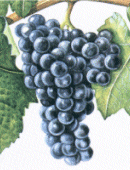 |
Spätburgunder (Pinot noir) is the Riesling's red counterpart (7% of the total vineyard area), producing elegant, distinctive wines. Its small grapes ripen late. It orginally came from the French province of Burgandy. Wine: velvety, full-bodied, with hints of almonds. |
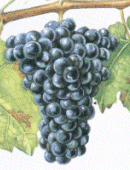 |
Portugieser Originally came from the Danube Valley in Austria (not Portugal). It ripens early (4%). Wine: flavourful, light, mild; very pleasant, easy-going wine. |
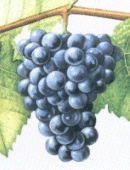 |
Trollinger Grows almost exclusively in Württemberg (2%) and probably originated in Tyrol. It ripens very late. Wine: fragrant, fresh, fruity, good acidity, hearty. |
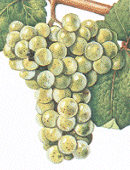 |
Riesling Wine: fragrant, fine-fruit bouquet; lively, pronounced acidity; piquant taste; potential for ageing because of racy acidity.
|
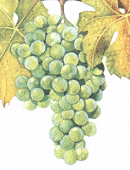 |
Müller-Thurgau Wine: flowery bouquet; milder acidity than Riesling; sllight juscat flavour; best consumed while fresh and young |
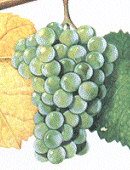 |
Silvaner Wine: neutral bouquet; mild acidity; full-bodied, pleasant wines; best enjoyed while young. |
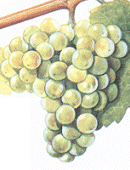 |
Kerner Wine: light muscat bouquet; racy, lively acidity; similar to Riesling. |
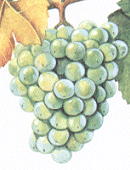 |
Scheurebe Wine: lively acidity; bouquet and taste reminiscent of black currents |
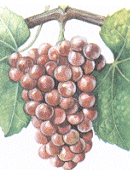 |
Ruländer/Grauburgunder Wine: robust, full-bodied, smooth, soft, and full on the palate. |
| Other varieties... | There are other whit wine varieties in Germany that are just as interesting and which you should try: the fruity, floweryBacchus, the light, mild Gutedel, the racy, neutral Elbling, or the Morio-Muskat, with its flowery bouquet and pronounced flavour. |
Well, there you have it. Everything you ever wanted to know about Germany and its wines. Well, close. But if you remember anything remember this: the degree of grape ripeness at harvest determines quality of german wines.